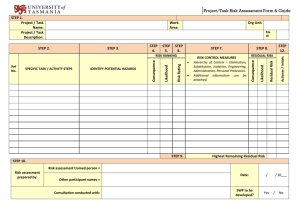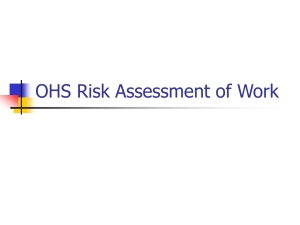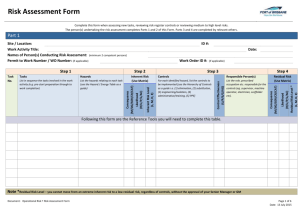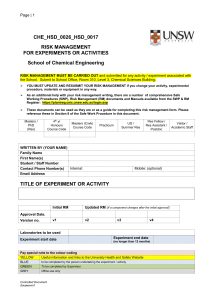Task Risk Assessment Form
advertisement
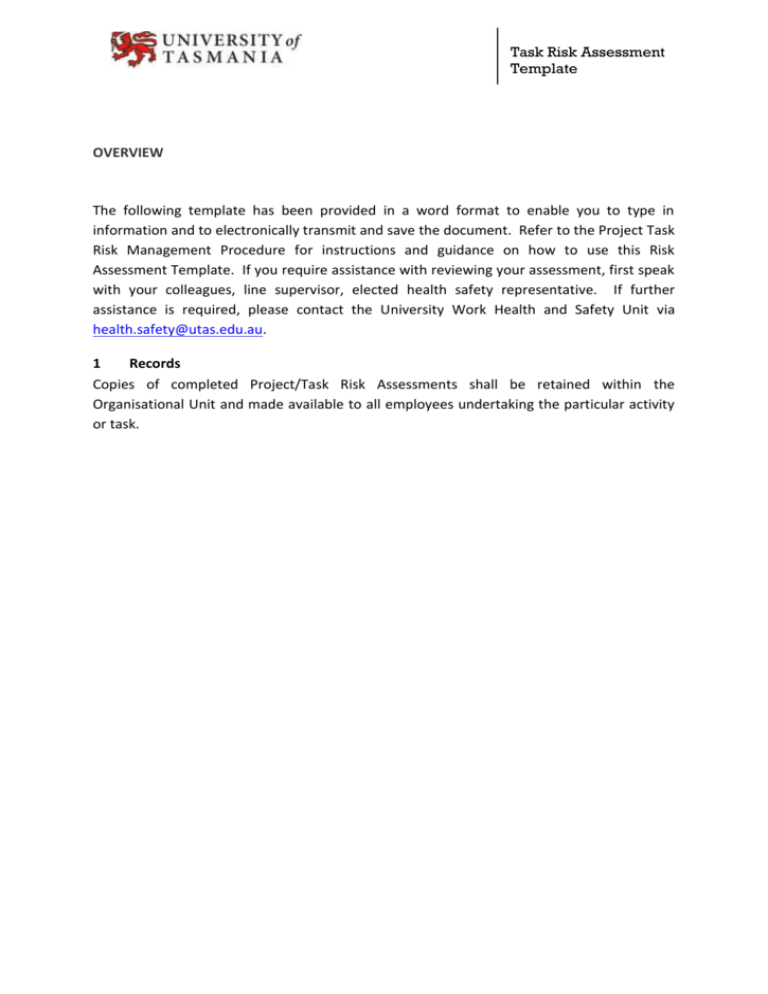
Task Risk Assessment Template OVERVIEW The following template has been provided in a word format to enable you to type in information and to electronically transmit and save the document. Refer to the Project Task Risk Management Procedure for instructions and guidance on how to use this Risk Assessment Template. If you require assistance with reviewing your assessment, first speak with your colleagues, line supervisor, elected health safety representative. If further assistance is required, please contact the University Work Health and Safety Unit via health.safety@utas.edu.au. 1 Records Copies of completed Project/Task Risk Assessments shall be retained within the Organisational Unit and made available to all employees undertaking the particular activity or task. Project/Task Risk Assessment Form & Guide STEP 1. Project / Task Name: Project / Task Description: Work Area: Org Unit File ID STEP 6. STEP 7. IDENTIFY POTENTIAL HAZARDS Risk Rating SPECIFIC TASK / ACTIVITY STEPS Likelihood Ref No. Consequence RISK RANKING STEP 9. STEP 12. STEP 8. RISK CONTROL MEASURES Hierarchy of Control – Elimination, Substitution, Isolation, Engineering, Administration, Personal Protection. Additional information can be attached. RESIDUAL RISK Actioner / Initials STEP 5. Residual Risk STEP 4. Likelihood STEP 3. Consequence STEP 2. Highest Remaining Residual Risk STEP 10. Risk assessment trained person = Risk assessment prepared by: Date: / SWP to be developed? Yes / 20___ Other participant names = Consultation conducted with: / No Project/Task Risk Assessment Form & Guide Residual Risk Extreme (E) High (H) Moderate (M) Low (L) APPROVAL REQUIRED TO PROCEED Approval Signature Approval Date: Approval must be obtained from a member of the UTAS Senior Management Team such as a Dean before work starts* Approval must be obtained from the Budget Centre Head/RO before work starts* Work can commence when a Budget Centre Head/RO or a nominated delegate e.g. Senior Lecturer/Researcher, or University Manager Level person has approved this risk assessment, & all identified control measures are in place. Work can commence when an approved University Staff member has approved this risk assessment, & all identified control measures are in place. Organisational Unit Head (or nominated delegate) must approve Risk Assessment if it is used to develop a SWP. * Discretion for the Organisational Head/Officer to approve Extreme / High risk work to proceed only applies where there is a risk to production loss/plant. This discretion does not apply to work if the Ext/High residual risk relates to the potential for personal injury or environment risk. Step 11. If the Project/Task does not involve any permits and sign-off sheets, or participants are not registered in the Fieldteq database, then all participants must sign on (and sign off when complete if relevant) before they are permitted to be involved in the Project/Task. By signing below, participants acknowledge they have read and understand the risk assessment and agree to comply with all steps and control measures: NAME SIGN ON DATE SIGN OFF DATE NAME SIGN ON DATE SIGN OFF DATE RISK CALCULATOR (Risk Rating = Consequences x Likelihood) LIKELIHOOD Almost Certain (5) Likely (4) Insignificant (1) M (11) M (7) Possible (3) L (4) Unlikely (2) L (2) Rare (1) L (1) STEP QUICK GUIDE OF WHAT TO DO CONSEQUENCE Minor (2) Moderate (3) Major (4) Catastrophic (5) H (13) E (20) E (23) E (25) H (12) H (17) E (21) E (24) M (8) H 16) E (18) E (22) L (5) M (9) H (15) E (19) L (3) M (6) M (10) H (14) MORE DETAILED INFORMATION ON EACH PROJECT/TASK RISK ASSESSMENT STEP Project/Task Risk Assessment Form & Guide 1. Complete a description of the Project / Task 2. Detail specific task steps 3. Identify potential Hazards for each Task/Activity in Step 2. Use WHS Hazard Prompt Sheet (Appendix 2) for help. 4. 5. 6. 7. 8. Evaluate the possible Consequence of the Hazard Use Risk Calculator above Evaluate the Likelihood of that Consequence Use Risk Calculator above Determine Risk Ratings of hazards Use Risk Calculator above Identify Controls to reduce hazard risk Evaluate the Residual Risk (risk rating with controls in place) At the top of the risk assessment record the task name, a brief description of the task, and the relevant work area and section. Keep as simple as possible, but with enough information to identify the task. If the Risk Assessment is being used to develop a Safe Work Procedure (SWP), the risk assessment task name should correspond with the title of the SWP. In the first column “Ref No.” write the step no. starting from 1. up until however many steps/tasks there are in the task. If applicable, these should align with any associated SWP to enable cross referencing. List each of the specific tasks, activities and/or steps associated with the project that will be undertaken. In the column next to listed tasks/activities, identify all potential hazards relevant to each item. Record each hazard on a separate line. A common mistake is to refer to a hazard as the actual harm or the health effect it caused rather than the hazard. E.g. If the task was hosing down an area, the hazard is the wet floor not the potential harm caused e.g. fall / cut knee. If no hazards are found for a task/step or the risk has been addressed in a previous hazard, the task still needs to be listed to show it has been considered, and to keep the steps/tasks in line with any associated SWP. Simply put if someone was exposed to the hazard, what would be the reasonable consequence? It is not always the “worst” case scenario; e.g. if you fell 1m off a ladder you could be killed as an extreme (e.g. land on your head), but the most likely consequence would be you might sprain your wrist or break a leg. Therefore the consequence is more likely to be moderate rather than catastrophic. Ask yourself will it ever happen; if so what factors are needed for it to happen, and how often would those factors be around. Then ask yourself what you think the reasonable frequency would be, before determining the Likelihood. 9. Determine highest remaining residual risk 10. Approval / SWP development 11. Sign on / off 12. Document Actioners Determine each hazard’s risk rating by intersecting the “Consequence” and “Likelihood” levels on the Risk Calculator table. For more detailed information on determining risk levels, refer to the Risk Matrix (appendix in Risk Management Policy CORP 13.1). Control measures need to reduce hazard risk ratings to an acceptable level if the current risk level is unacceptable; aim for a low risk. Apply the Hierarchy of Control when determining control measures (refer to Minimum Standard: Risk Management Project/Task – 1.3). After control measures have been identified, you need to reassess each hazards risk rating to determine what the remaining risk would be with the controls in place from Step 7 (follow the principles in Steps 4 & 5 above). The aim is to achieve a Low Risk; if not achieved review controls again and/or ask for help. If the highest residual risk on the risk assessment is a Low Risk, or a Moderate Risk the task/project can commence once all control measures are in place and the risk assessment has been reviewed and approved. If a High or Extreme risk still remains, then the task/project must not commence and further review must be undertaken involving the Budget Centre Head/RO or a member of the UTAS Senior Management Team such as a Dean (an Elected Safety Representative should also be involved). Exemption: In exceptional circumstances, if the “Ext” or “High” risk rating does not apply to personal injury or environmental damage (e.g. potential for property damage only), and the Budget Centre Head/RO in consultation with the WHS Unit believe it is an acceptable risk for the University, the task may be approved. This does not apply for Personal injury or Environmental risks; a “M” (Moderate) risk is the highest ranking allowable. Once the risk assessment is complete, all participants should record their name at the bottom of the sheet, document any consultation that was had (e.g. tabled at WHS Committee) and the Budget Centre Head / RO or delegate should sign off the task for approval. Specify if a safe work procedure (SWP) is required to be developed (e.g. for routine / regular tasks). If yes, this should be done in accordance with the Minimum Standard - Safe Work Procedure Development. All persons involved in a project/task must acknowledge they have read and understood a risk assessment and agree to comply with all steps and control measures. Reference the initials of the person responsible for ensuring a particular control is implemented before progressing with the task/project. WHS Hazard Prompt Sheet PROJECT / TASK PREPARATION CONSIDERATIONS INCLUDE: Safety glasses Double eye / Face shield 1st aid equipment/Trained first aiders Earplugs (Specify class: ___________) Fire equipment Helmet Other emergency response Emergency High-visibility Chemicals approved for job Response / Safety boots Chemical/Oil spill kit Minimum PPE Plant / Long sleeves/trousers Vehicular type / access / parking Equipment / Coveralls Amenities / Facilities / Hours of work Access Respirator (Specify type: __________) Signage / Barricades UV protection (Hat, glasses, etc) Communication equipment Gloves (Specify type: _____________) Registered plant Other: POTENTIAL HAZARDS ASSOCIATED WITH THE PROJECT/TASK RESULTING FROM (but not limited to): CATEGORY CONSIDER CATEGORY CONSIDER Hot Work (Welding, cutting, grinding, etc) Repetition / Overuse Manual Confined Space Entry (e.g. suffocation) High / Low reach Handling Isolations High force / Heavy loads (Ergonomic) / High Voltage Awkward / Unbalanced loads Permit to Work Human / Working at Heights Pushing / Pulling / Twisting Muscular Asbestos Carrying & walking Surface Disturbance (Excavation/Demolition) Over exertion (e.g. fatigue) Radiation Design / Layout Personal characteristics e.g. height Working alone / Remote work Emergency Inappropriate chemical storage/use Steam / Condensate Thermal Hot or cold materials/surfaces Fire / Explosion Self-ignition combustibles (e.g. dust) Fire (e.g. burns) Heat stress / Cold Hazardous Subs/Dangerous Goods Working at height / Unguarded edge Chemical / Inadequate storage/bunds/labelling Struck by falling/lowering object Environment Gas / Dust / Fumes (e.g. explosion) Gravitational Rolling/Sliding objects Poor ventilation Ascending/Descending stairs / ramp / ladders / Inhalation / Absorption / Skin contact platform / mobile equipment Waste/Contamination e.g. soil/water/air Lifting equipment (e.g. crane, sling) Inadequate training / experience Injured by people Holes/Gaps or Slip/Trip hazards Procedural Incorrect equipment selection / use or objects falling Scaffolding Unbalanced ladders Traffic / pedestrian interaction Structural failure / Exceeding load ratings Vehicle instability e.g. rollover Kinetic Energy Exceeding rated capacity Hazards resulting in electrocution / burns; E.g. / Mobile Plant Electrical Obstructed / Poor Visibility Cables: Unsafe condition/location / Pedestrians Being hit by the activities of another No earth leakage protection person, moving vehicle or object High voltage / Switch rooms Training / Competency / Compliance CATEGORY Mechanical Pressure General Work Area / Housekeeping High risk licenses Certificates of competency Experience Induction training required Project / Area Supervisor Any relevant legislation Consultation / Notifications Any literacy issues CONSIDER Unguarded moving parts (e.g. crush) Drawing in / cutting points (e.g. nips) Impact and crushing areas Uncontrolled movement Tearing / Shearing (e.g. abrasions) Unsafe access Auto-start equipment Inadequate isolation points Hand & power tool condition Stored energy (e.g. vessels) Failure of plant (e.g. loss of load, plant ejection, collapse, fragmentation) Compressed gases Hydraulic / Vacuum HP steam / Water Time of day and illumination/glare Wet / Slippery / Uneven surfaces Weather & outdoors e.g. wind, UV, fog Unauthorised personnel entry Noise / Vibration Biological – fluids, sharps, insects Inadequate maintenance/inspections Restricted work area Any foreseeable abnormal conditions? Any other hazardous conditions? Qualitative Risk Assessment Table Consequence – descriptions are an extract from the full UTAS Risk-Matrix RISK CALCULATOR E = Extreme risk WHS, HR Injury report &/or 1st aid only; substantial stress reducing work effectiveness without lost time. Medical treatment injury (MTI); Substantial stress requiring professional clinical support. Environment, Community Brief pollution: No discernable impact; internal report, liability <$5k Transient harm: minor effects on environ, minor localised shortmed term damage; liability $5k-$50k Political, Reputation & Image Issue resolved internally by day-to-day processes; little or no stakeholder interest. Issue raised by students / local press; minor adverse public / media attention & complaints. Student/Community concern; heavy local media coverage; criticism by NGOs; reputation affect with some stakeholders. Significant adverse media coverage (national/public); reputation impacted with significant no. of stakeholders; breakdown in business partnership Business, Quality & Infrastructure Negligible business interruption, brief loss of service; <10 recommendations from licensing body; event absorbed through normal activity; loss of >1 days research/work Minor delivery delays; loss of 1-5 days research/ work; loss of up to 10 EFSLs; event requires mgt attention to minimise impact; >2 license non-compliances Significant event; loss of 10-100 EFSLs; 2+ non-compliances& license under threat; loss of 5days – 6wks research/work; critical service interruption. Major event; loss of 100+ EFSLs; limited accreditation/ licensing; loss of 6-13wks research/work; critical infrastructure service loss for <1 month Legal Adverse regulatory action unlikely Regulatory action not likely; minor legislative breach Serious legislative breach; potential for regulatory action e.g. fine, prosecution Major legislative breach; possible investigation, prosecution &/or major fine Financial 0.5% of Budget; <$5K for School/Faculty 0.5-1% of Budget; <$5k - $50K for School/Faculty 1-5% of Budget; $50k0.5m for School/Faculty 5-10% of Budget; $0.5-$5m 10% of Budget; >$5m for School/Faculty Insignificant Minor Moderate Major Catastrophic 1 2 3 4 5 H = High risk M = Medium risk L = Low risk Residual High or Extreme risks must be reported to Budget Centre Heads / RO and require detailed action plans / control measures to reduce the risk to Low or Medium before a project/task can commence. Probability: Likelihood Occurs weekly Occurs monthly Yearly; 1 in 20 chance Once in every 10 years; 1 in 100 chance Less than 1% chance of occurring Historical: Expected to occur in most circumstances Will probably occur in most circumstances Might occur at some time Hospitalisation (less than 3 days lost time); serious temp disability; minor permanent disability. Moderate harm: Measurable environ impairment but not on ecosystem; shortmed term impacts; liability $50k-$500k Hospitalisation (longer-term); single death; permanent disabilities (multiple persons). Multiple deaths &/or permanent disability (5 plus persons). Significant harm: Serious environ effects, some ecosystem impairment; medlong term impacts, recovery once clean up complete; liability $0.5m-$5m Long term harm: Serious environ widespread effects, significant impairment of ecosystem function; remediation required; liability >$5m Reputation affected national & international, & with majority of key stakeholders; serious public / media outcry; significant breakdown in business partnerships Extreme event – potential for collapse of part of business; school viability threatened (loss of students / clients); limited accreditation; loss of 13+wks research//work; critical infrastructure loss >1 month Significant prosecution / fines likely; “wilful” / ”negligent”; potential significant litigation e.g. class action 5 Almost Certain M (11) H (13) E (20) E (23) E (25) 4 Likely M (7) H (12) H (17) E (21) E (24) 3 Possible L (4) M (8) H (16) E (18) E (22) Could occur at some time 2 Unlikely L (2) L (5) M (9) H (15) E (19) May occur but in exceptional circumstances 1 Rare L (1) L (3) M (6) M (10) H (14) Adapted from AS/NZS 4360: Risk Management
